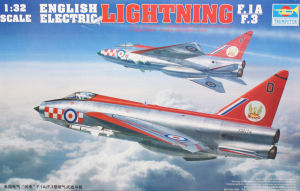
Trumpeter 1/32 Lightning F.1A/F.3 Kit First Look
By Michael Benolkin
| Date of Review | February 2009 | Manufacturer | Trumpeter |
|---|---|---|---|
| Subject | Lightning F.1A/F.3 | Scale | 1/32 |
| Kit Number | 2280 | Primary Media | Styrene, White Metal |
| Pros | Nicely detailed, relatively simple build | Cons | |
| Skill Level | Intermediate | MSRP (USD) | $179.95 |
First Look
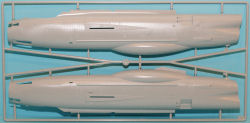 |
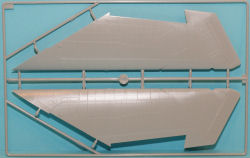 |
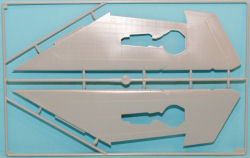 |
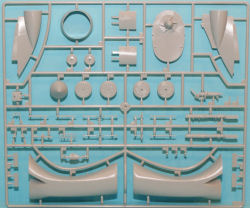 |
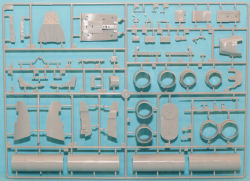 |
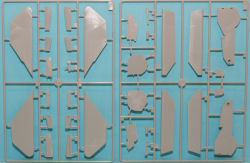 |
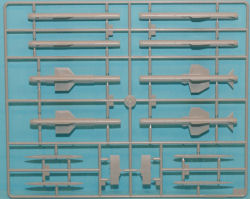 |
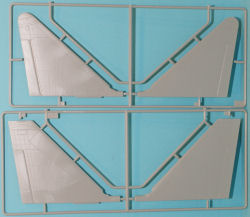 |
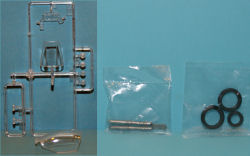 |
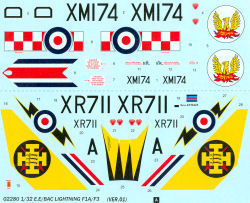 |
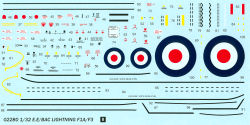 |
As Britain and the rest of the world transitioned from World War 2 into the Cold War, the RAF took its hard earned lessons for the defense of Britain forward into the supersonic and nuclear age. Where Fighter Command would rise up to meet the oncoming Luftwaffe in World War 2, the RAF needed to reach the threat as quickly as possible and as far away from Britain as possible, just in case the destruction of an enemy bomber resulted in a nuclear detonation.
English Electric designed an innovative high performance interceptor concept, designated as P.1, which first flew in the mid-1950s. The design was incrementally improved until the P.1B became the first British aircraft to exceed Mach 2. The resulting aircraft from this development became the Lightning.
Lightning was powered by a pair of Rolls Royce Avon engines which developed enough thrust in full afterburner to give the Lightning nearly a 1:1 thrust-to-weight ratio. To keep the frontal area (and therefore drag) to a minimum, the engines were mounted one atop the other. The wings were swept 60 degrees to further minimize high speed drag, though the wing tips were angled perpendicular to the fuselage and they contained the ailerons for roll control. The radar was mounted in the intake centerbody (similar to the MiG-21). Altogether, the aircraft is high performance even by today's standards, though there wasn't much room left over for fuel, so at best, the Lightning was a high-performance point-defense fighter.
Even against the F-15 and F-16, the Lightning could out perform these aircraft in extreme intercepts. During intercept trials against the U-2, a Lightning F.3 was able to pop up to 88,000 feet and pay the U-2 a visit. During intercept trials against the Concorde, the Lightning was the only fighter capable of overtaking the Mach 2+ target from behind (the only other operational aircraft capable of this is the MiG-25). The Lightning defended Britain until finally replaced by Tornado F.3 in 1988.
The Lightning is definitely one of those shapes that looks like it is traveling at high speed even sitting still. Several kits of this distinctive aircraft have been on the market in the smaller scales, but it wasn't until Airfix released their 1/48 Lightning that the modeling community had a larger rendition of this subject. Who would have imagined that we'd ever see this aircraft in 1/32 scale?
Trumpeter's highly anticipated kit has finally landed! This first release represents your choice of the Lightning F.1A or Lightning F.3. The F.1A was armed with Aden cannons and the Firestreak missile. It was also the first variant with an air refueling probe. F.3 was the 'sport model' with the larger Avon engines but not yet with the larger (higher drag) ventral fuel tank. F.3 deleted the cannons and replaced the Firestreak missile with the Red Top. The aerodynamic effects of the newer missiles led to a shorter, wider chord vertical stabilizer starting with Lightning F.3.
The kit is molded in light gray styrene and presented on ten parts trees, plus a single tree of clear parts. The main gear struts are white metal, and the landing gear features rubber tires. In all, the kit is comprised of 163 parts. According to the specs, the model will be over 20" long with a span of over 13".
As with any good aircraft kit, construction starts in the cockpit, and let me say that this is one of the nicest cockpits out of Trumpeter to date. The nicely done ejection seat is 15 pieces. The side consoles and instrument panel are molded with nice sharp detailing that will look very nice with careful painting and dry-brushing. You'll need photo-etched seat belts and shoulder harness for the seat, we should be seeing a color-printed photo-etch set from Eduard for this kit in the future.
The main instrument panel is molded in clear, with instrument faces printed on clear acetate to sit behind the clear panel. Simply mask the instrument faces, paint the panel, and you'll be able to get some nice results.
The intake centerbody/shock cone houses the radar and the radome is separately molded so that painting will be easier and you can install the radome later. The centerbody unit also houses the nose gear well and the detailing here looks like a good start.
The centerbody unit installs inside the nose intake duct, and the rear of the duct is blocked out so you won't see back into the rear of the model. The lower portion of the duct has one engine face visible, which oddly looks like the Trumpeter rendition of the F-100 and F-8's J79. Once again, they've molded the main stators in that odd angle. No biggie, you'll need a strong light to see back there anyway.
The afterburner chambers are nicely done, though I might want to rework the afterburner spray rings so that I can have a turbine face visible behind each one.
The wings are a simple affair, install the main wheel wells and put the halves together. I am really concerned here as there isn't much surface area to glue to the fuselage and I fear you'll have wing failure should you lift the model by the wing once too often. The solution is simple - use either brass rod or Plastruct I-beams (or your own preferred medium) drilled through the fuselage and into the wings to form a main spar. Two spars would be good here and they will add strength to the wing/fuselage joint.
Kudos to Trumpeter for providing the main gear struts in white metal. I fear that long styrene struts would fail in short order.
I'm not thrilled about the way that the horizontal stabs plug into the fuselage at an angle, but there aren't many options here. Where on other aircraft I might use a brass rod through the fuselage to interconnect the stabs, in this model that rod would be running straight through the lower engine afterburner chamber. Here is where liquid cement and some solid curing time will pay off.
Summing up, among the features in this kit:
- Nice cockpit
- Positionable canopy
- Metal main gear struts
- Choice of guns (F.1A) or no guns (F.3) in nose
- Positionable speed brakes
- Choice of vertical stabilizers
- Choice of Firestreak or Red Top missile
- Rubber tires
You have two marking options in this kit:
- Lightning F.1A, XM174, 56 Sqn, RAF Wattisham, 1963
- Lightning F.3, XR711, 111 Sqn, RAF Wattisham, 1965
This kit turned out rather nicely. I was impressed with the test shots at the hobby show last year, but there's nothing like holding the final results of this nice kit.
With two different versions in this boxing, you can render an early or mid-production variant of this RAF hotrod. I don't doubt that we'll see other variants like the F.6 in our future, but for now, you have some nice options for your next project right here.
My sincere thanks to Stevens International for this review sample!







